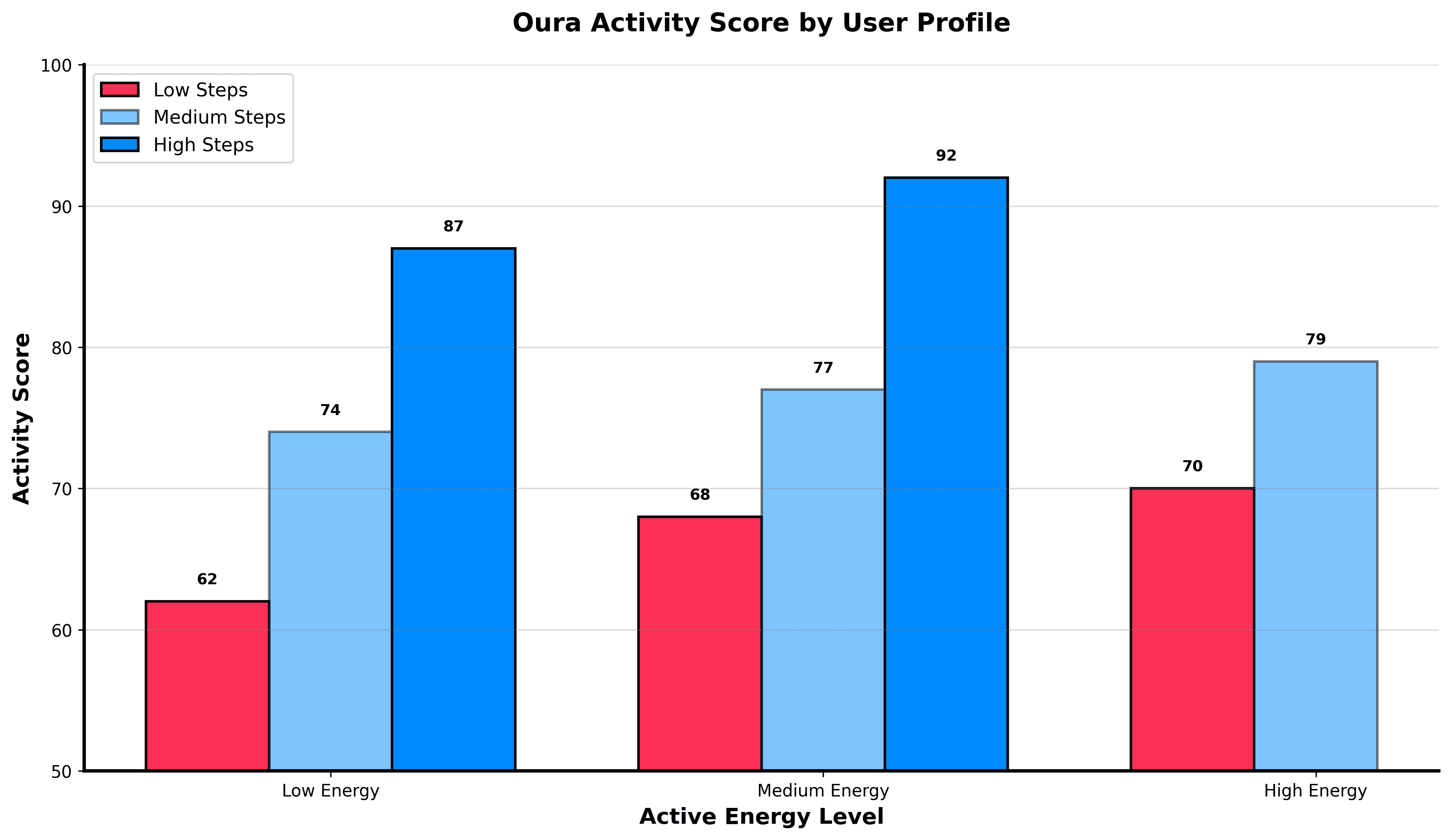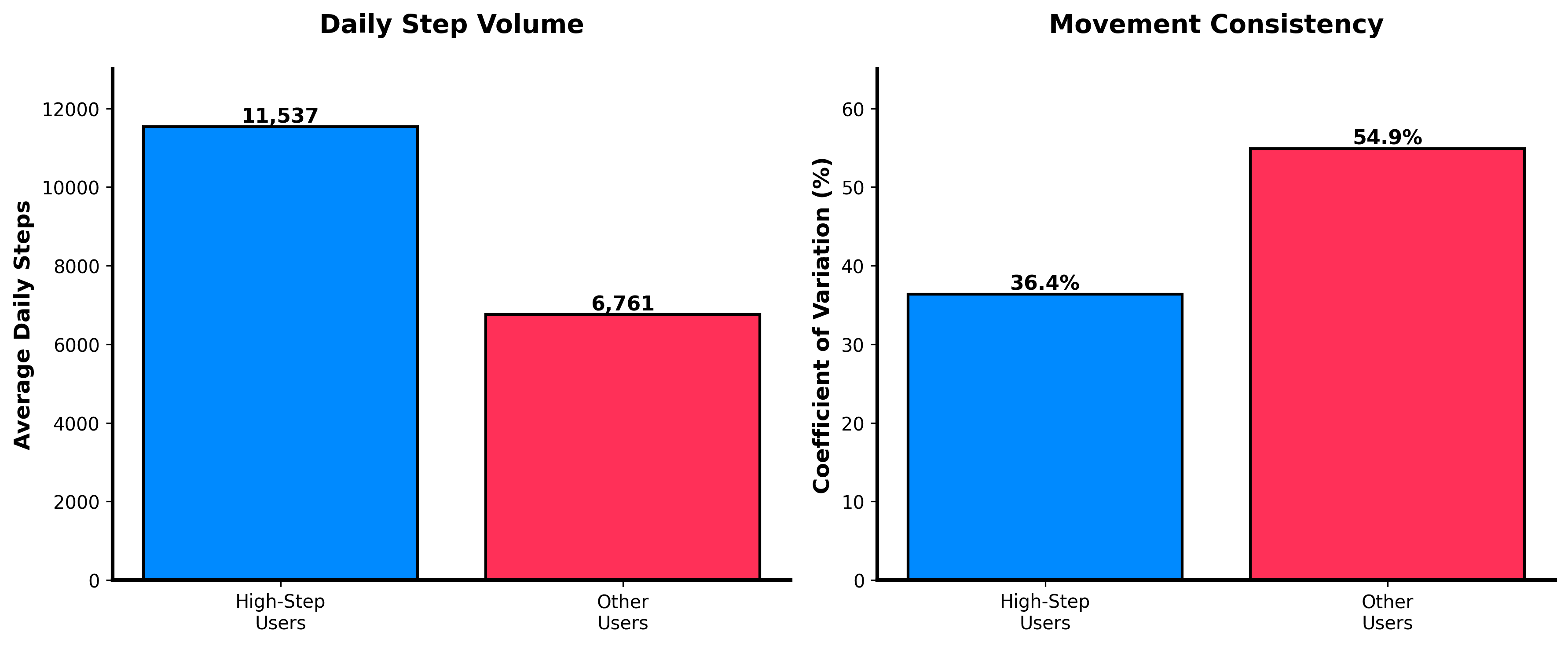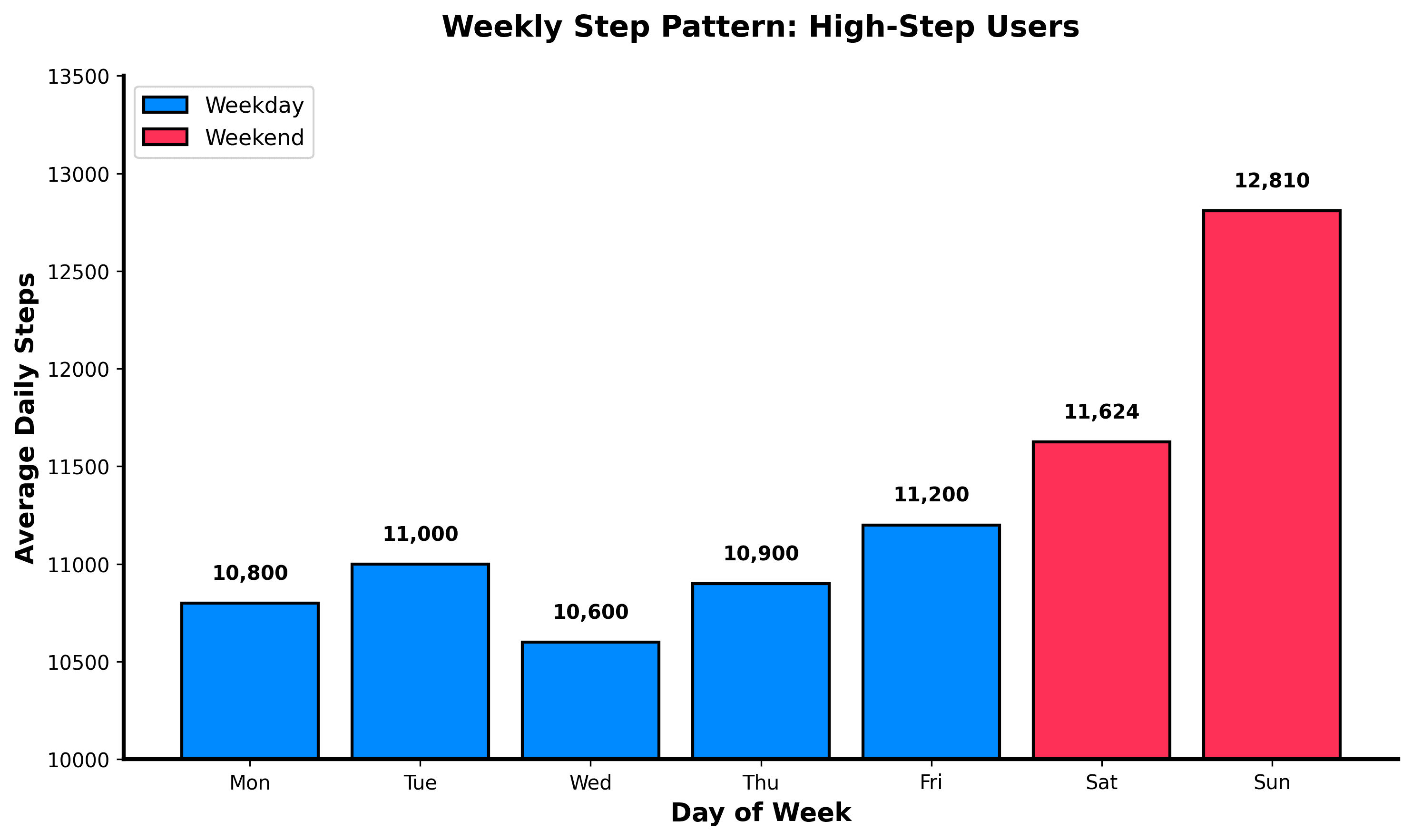- There are some step champions out there: High-step users average over 11,500 steps a day with correspondingly higher activity scores, calorie burn, and logged days.
- Consistency is the secret ingredient: High-step groups show much lower variability (Coefficient of Variation), 36% vs 55% in others, proving that steady, repeatable habits are the key to logging the most exercise over weeks and months.
- This points to the power of practical habits: small, regular behaviours, such as walking meetings, active commutes, and standing desks, build sustainable routines that support health more reliably than occasional extremes.
Oura Ring Series
Is Consistency Actually More Important Than Intensity?
October 23, 2025
Stay updated with our latest research
Get the latest reports and insights from Terra Research delivered to your inbox.
Is Consistency Actually More Important Than Intensity?
As activity data is so essential to all of our lives, I felt the dataset deserved some more attention, so I analysed the daily activity data of the same Oura Ring users for some deeper insights. By examining step volume (the number of steps people take) and active energy (Calories burned from activity/exercise), I identified eight distinct user profiles, ranging from low-step sedentary types to high-step movers with ample active energy. Group profiling is a tool we use at Terra Research to help inform our logic as we try to make health models individualised. It allows us to ask: How does this group of similar users respond to something? And hopefully see a response that we wouldn’t at the individual level.
Read on for a deep dive into each profile. I’ll highlight differences in steps, active minutes, calories, and Oura’s Activity Score, and explain why consistency, as measured by the Coefficient of Variation (CV), matters so much. We’ll then examine high-step profile users to identify what sets these step champions apart, and hopefully, you can take away some practical advice for building sustainable habits.
The Eight Activity Profiles (Step Volume × Active Energy)
Roughly half of the cohort live in the middle lane for steps, with the following breakdown: medium steps, low active energy (64 users, 17%); medium steps, medium active energy (58 users, 16%); and medium steps, high active energy (57 users, 15%).
Pushing beyond average steppers, we encounter the heavy hitters: high steps, high active energy (37, 10%); high steps, medium active energy (32, 9%); and high steps, low active energy (24, 7%). At the quieter end, there are low steps, with medium active energy (27.7%) and low (6.7%) activity. Finally, low steps with missing active-energy data (23.6%) complete the picture.
Here’s the summary of how each group moves, how many calories they burn, what Activity Scores they earn and, crucially, how consistent (as measured by Coefficient of Variation) they are:
- Low Steps, Low Active Energy. Minimal movement, largely sedentary, Activity Score in the low 60s; daily routine is consistently inactive (moderate CV).
- Low Steps, Medium Active Energy. Occasional brisk walks or workouts but low overall volume; sporadic behaviour gives a high CV.
- Low Steps, High Active Energy. Short, vigorous sessions (HIIT, spin) amid otherwise sedentary days; the most erratic profile with the highest CV.
- Medium Steps, Low Active Energy. Casual movers who stroll through 6–7k steps daily; steady pattern, low CV, Activity Scores typically in the 70s.
- Medium Steps, Medium Active Energy. Balanced lifestyle: 6–10k steps with brisk effort, Activity Scores mid–high 70s, CV moderate.
- Medium Steps, High Active Energy. Frequent vigorous exercise plus only moderate total steps; an all-or-nothing pattern yields a higher CV.
- High Steps, Low Active Energy. On-their-feet lifestyles (e.g. teachers, nurses) racking up 10–12 k+ steps gently; exceptionally steady (very low CV) and high Activity Scores.
- High Steps, Medium Active Energy. The model movers: high step counts and moderate-to-brisk effort, Activity Scores consistently 85–95, CV very low.
- Missing Active-Energy Data. Movement recorded, but no medium/high active-energy periods detected; behaviour mirrors whatever their step volume is.

Key Comparisons across Profiles
- Steps: High-step users average 11,500+ daily steps – about 70% more than the rest, who hover around 6,700.
- Active Minutes: More steps (obviously!) means more time spent moving; high-step groups log 7.1h/day versus 5.2 h for others.
- Calories: High-step movers burn 8.7 % more total calories (2,591 kcal vs 2,384 kcal).
- Activity Score: Volume plus at least some active energy drives scores. Low-step groups sit in the 50–60s, medium-step in the 70s, high-step in the 80–90s.
- Consistency: CV values highlight reliability: high-step users just 36.4 %, others 54.9 % on average – an 18.5-point gulf.

The High-Step Heroes
The single biggest mover amassed 1,457,274 steps over 84 days (17,348 per day). All top-ten users exceeded 1.1 million steps, averaging 12,800–17,300 steps daily and tracking for 83–88 days straight. Compared with everyone else, they record:
- +70.6 % more steps (11,537 vs 6,761).
- +35.5 % more active minutes (25,593 seconds per day vs 18,889 s).
- +11.5 % higher Activity Score (92.6 vs 83.0).
- +17.9 % more days logged (83.9 vs 71.1).
Their week shows an even steeper weekend surge: Sunday averages 12,810 steps, Saturday 11,624, with Wednesday still above 10,600. Crucially, their CV is an impressive 36.4 %, underscoring that sheer volume alone does not explain success; regularity does.

Why Consistency Matters
A low CV signals behaviour you can bet on: stress is applied steadily, recovery keeps pace, and habits cement. The human body likes consistency; that way, it doesn’t have to fight to maintain internal homeostasis. High variability, the hallmark of many low-step, high active-energy “boom-and-bust” patterns, increases injury risk, hinders adaptation and often derails motivation. Studies show that regular, moderate activity drives weight control, lowers blood pressure and improves mood more reliably than erratic bursts. Think of CV as your habitometer: if yours is high, aim to lift the low days rather than inflating the peaks.
Takeaways
- Move daily. Even ten minutes of walking on your busiest day keeps CV in check and habits alive.
- Raise your baseline gradually. Add 2,000 steps to your daily average before dreaming of the big weekends.
- Mind your CV. Got roller-coaster patterns? Smooth them by sprinkling light activity on days you wouldn’t normally move.
- How do I do this? Walking meetings, standing desks, and (my personal favourite) active commutes turn movement into habits.




